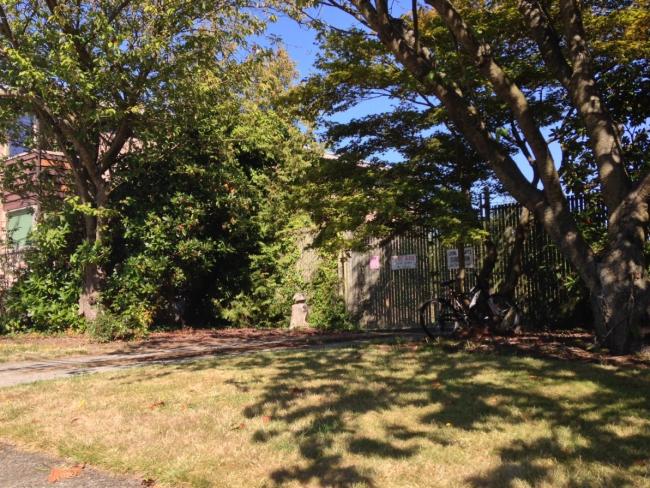At Large in Ballard: A New Cause
Loyal Heights substation.
Wed, 03/11/2015
By Peggy Sturdivant
On January 4, 2015, the Seattle Green Spaces Coalition held a meeting at the High Point Branch library, possibly the first community meeting of the year. Two weeks later, that long ago day when the Seahawks pulled off the championship in the final two minutes, I was enroute to the Southwest Branch library for another meeting about green spaces. When we heard fireworks we inferred the amazing turnaround.
Those of us who want to keep former Seattle City Light substations for public use are hoping for a similar turnaround. That’s why I have been trekking to West Seattle for weekend meetings and they have journeyed to Ballard. We need it because the King County housing market is “hot” with another 6% increase in home prices since one year ago according to a Seattle Times analysis. Demand is up; supply of homes and condominiums is low. So developers are eager to maximize lots by demolishing existing structures or acquiring land. Since Seattle is now the fifth fastest growing city in the country, how can we hope to hold onto undeveloped land?
As Seattle City residents, we can hope that the city’s 2013 Climate Action Plan calling for open spaces, carbon reduction and tree canopy will save some land from development. By extension we can “hope” that Seattle City Light properties (which they list as either surplus or excess) remain land for the public. Which is why Seattle Green Spaces Coalition, of which I’m now a member, has adopted the phrase, “Keep This Land in Public Hands.”
The issue of former substations isn’t new; it was covered by the BNT in 2007 and again November 11, 2014. What has changed is the urgency. The City is moving forward to sell its land and buildings, and the City Light’s policy is to sell to the highest bidder. In NE Seattle substations there was little – if any – public warning before For Sale signs were posted and new construction began.
In Seattle and Balllard we can see all the cranes and ‘Notice of Land Use’ signs. It’s a boom town! Bartell Drugs #22 was leveled in three days; new construction on 22nd NW will soon rise high above the library’s green roof. Will Seattle’s green spaces just be on rooftops?
Granted, what can be built on a former substation depends on the zoning. The former View Ridge substation at 7705 44th Ave NE was zoned as single-family, so the new owner is building a very large house. In comparison, here in Ballard, the Department of Planning & Development just approved construction of a 33-unit apartment building at 1506 NW 61st St, a 4750 square foot lot (existing single-family home to be demolished). There is only one surplus substation property smaller than that in Ballard, across from Ballard High School’s football field. Just imagine what could be built on larger lots.
Imagine instead creating more P-Patches or green spaces. And that’s why I have been dragging myself to West Seattle to build a coalition of community groups and neighbors: so that we have a say in what happens to public lands. We need to halt their sale without public process and get the various city departments working together on all their goals, from sustainability to affordable housing, from tree canopy to pedestrian safety. If Ballard can rally and save its substations it will help save other lands throughout the city.
So this is an invitation to learn more about “my new cause” (calling it that helps me feel more energetic). On Sunday, March 22, 2015, everyone who wants a voice in shaping the future of Ballard and of Seattle is invited to an open house at the Sunset Hill Community Association Clubhouse. The goal is to find common interests, combine forces and become a powerful force affecting policy around land use.
At the “Keep this Land in Public Hands Open House,” co-sponsored by Groundswell NW and TreePac.org, you can learn the locations of all the substations, meet those who have already agreed to become stewards, see photos of what has happened to former substations (good and bad) and become part of creating something positive and potentially beautiful. It’s not too late for these parcels of land. Perhaps we can keep them from becoming microhousing that isn’t even affordable, or apartments that are overpriced. Besides, you will be surprised to learn that these substations are hidden all around us. By Ballard High School, on Phinney Ridge, on 15th, 19th, 24th, 28th and right next to the VFW Hall on NW Market. And the NW 65th substation where many of us want to fulfill the Carrie Gustafson’s dream to create a space for artists.
The substation lots are already home to native plants and fruit trees, birds and bees. Seattle Green Spaces Coalition is working to halt the private sales so that each community can determine what would benefit their neighborhood. If food and free plants sounds more enticing than land use planning there will be appetizers and seedlings, the start of a treasure hunt: a fitting beginning to a spring to follow the winter that never was.
Sure, there are many problems to overcome, money issues, remediation needs, community concerns with the former substation land. But as former City Council member, architect and urban planner Peter Steinbrueck has said, “It’s tragic to see loss of (green space) when it’s within our ownership.” So I also quote Groundswell NW founder Lillian Riley, “You start where you can start.” No need to travel to West Seattle during a Seahawks game, just Sunset Hill Community Association Clubhouse on Sunday, March 22 from 5-7. We can all start there.
Seattle Green Spaces Coalition and Groundwell NW Open House. March 22, 2015, 5-7 p.m. SHCA Clubhouse, 3003 NW 66th. www.seattlegreenspacescoalition.org


